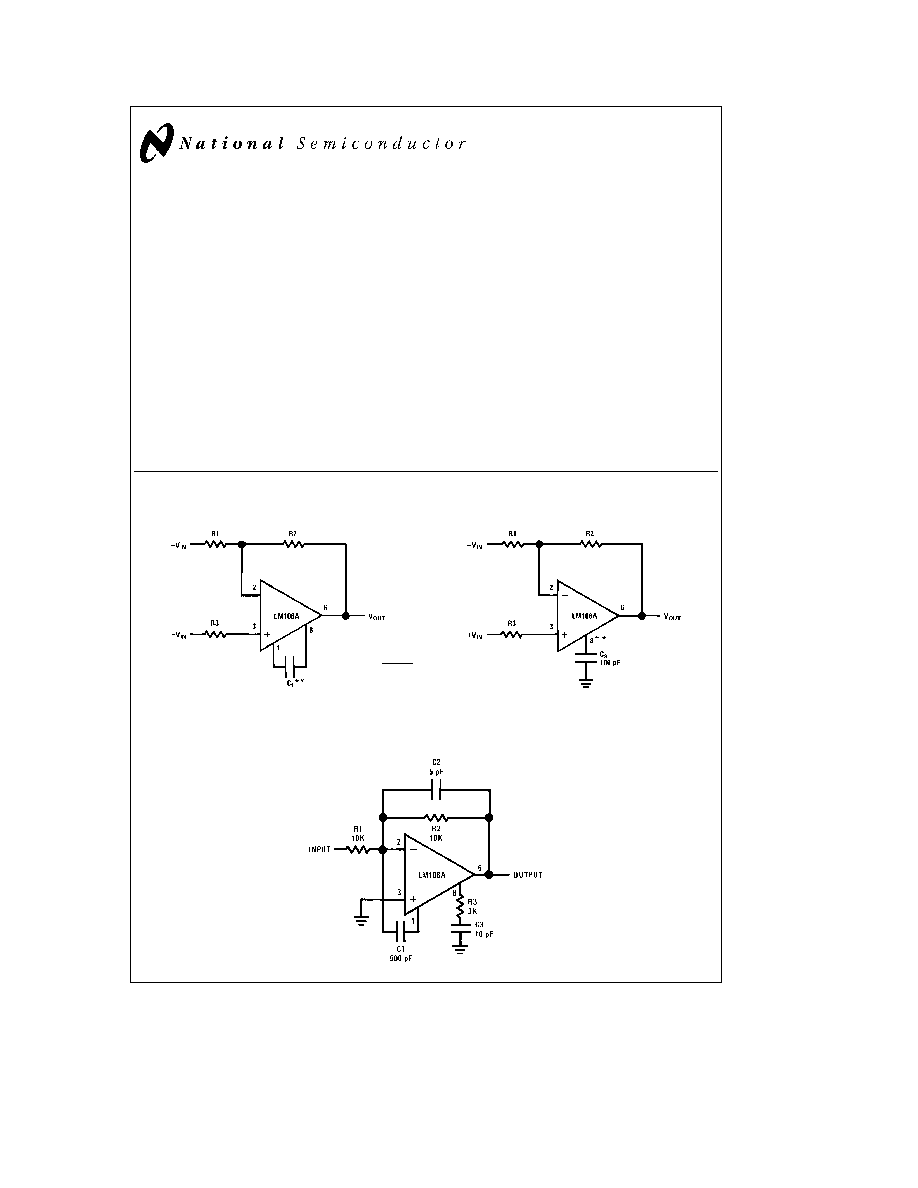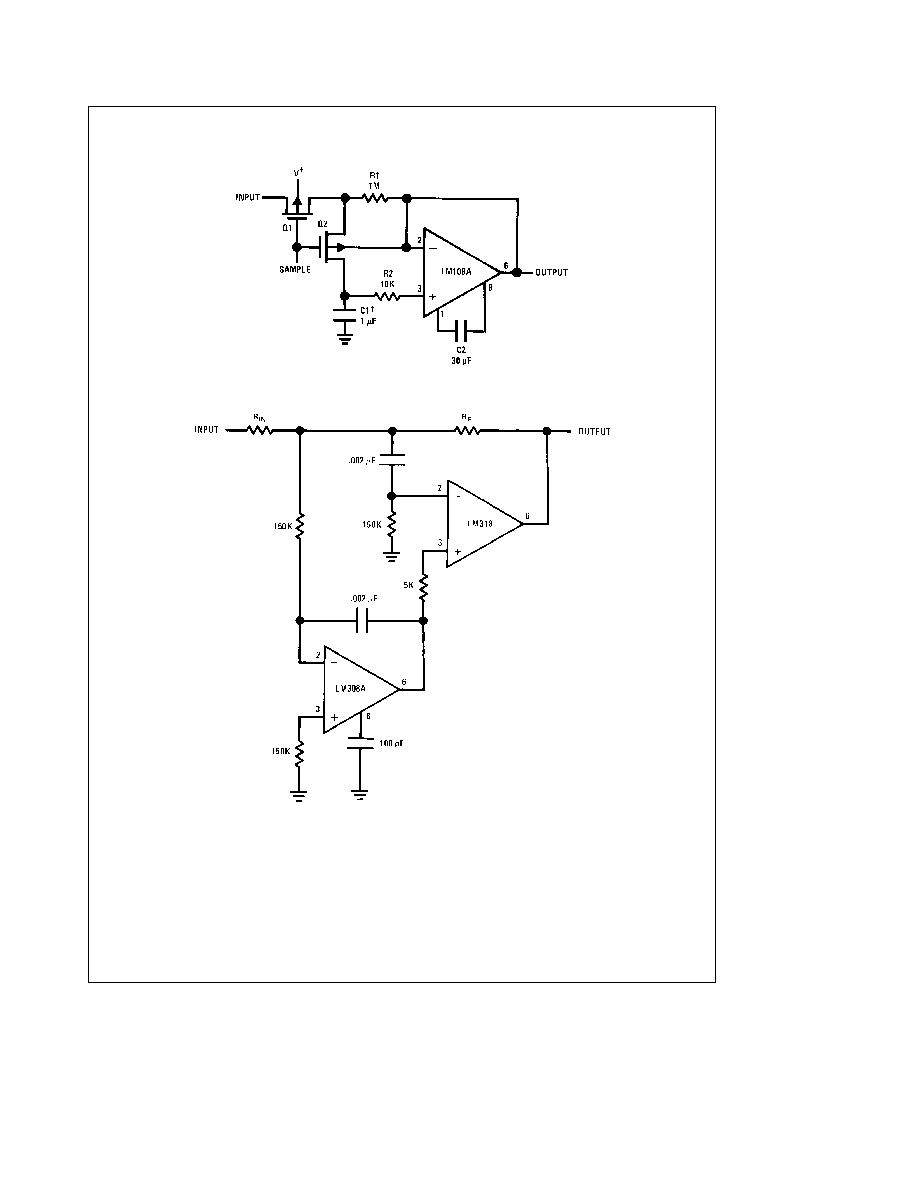
TL H 7759
LM108ALM208ALM308A
Operational
Amplifiers
May 1989
LM108A LM208A LM308A Operational Amplifiers
General Description
The LM108 LM108A series are precision operational ampli-
fiers having specifications about a factor of ten better than
FET amplifiers over their operating temperature range In
addition to low input currents these devices have extremely
low offset voltage making it possible to eliminate offset ad-
justments in most cases and obtain performance ap-
proaching chopper stabilized amplifiers
The devices operate with supply voltages from
g
2V to
g
18V and have sufficient supply rejection to use unregulat-
ed supplies Although the circuit is interchangeable with and
uses the same compensation as the LM101A an alternate
compensation scheme can be used to make it particularly
insensitive to power supply noise and to make supply by-
pass capacitors unnecessary
The low current error of the LM108A series makes possible
many designs that are not practical with conventional ampli-
fiers In fact it operates from 10 MX source resistances
introducing less error than devices like the 709 with 10 kX
sources Integrators with drifts less than 500 mV sec and
analog time delays in excess of one hour can be made us-
ing capacitors no larger than 1 mF
The LM208A is identical to the LM108A except that the
LM208A has its performance guaranteed over a
b
25 C to
a
85 C temperature range instead of
b
55 C to
a
125 C
The LM308A devices have slightly-relaxed specifications
and performances over a 0 C to
a
70 C temperature range
Features
Y
Offset voltage guaranteed less than 0 5 mV
Y
Maximum input bias current of 3 0 nA over temperature
Y
Offset current less than 400 pA over temperature
Y
Supply current of only 300 mA even in saturation
Y
Guaranteed 5 mV C drift
Compensation Circuits
Standard Compensation Circuit
C
f
t
R1 C
O
R1
a
R2
C
O
e
30 pF
TL H 7759 ≠ 1
Bandwidth and slew rate are proportional to 1 C
f
Bandwidth and slew rate are proportional to 1 C
s
Alternate Frequency Compensation
Improves rejection of power supply
noise by a factor of ten
TL H 7759 ≠ 2
Feedforward Compensation
TL H 7759 ≠ 3
C1995 National Semiconductor Corporation
RRD-B30M115 Printed in U S A

LM108A LM208A Absolute Maximum Ratings
If Military Aerospace specified devices are required
please contact the National Semiconductor Sales
Office Distributors for availability and specifications
(Note 5)
Supply Voltage
g
20V
Power Dissipation (Note 1)
500 mW
Differential Input Current (Note 2)
g
10 mA
Input Voltage (Note 3)
g
15V
Output Short-Circuit Duration
Continuous
Operating Free Air Temperature Range
LM108A
b
55 C to
a
125 C
LM208A
b
25 C to
a
85 C
Storage Temperature Range
b
65 C to
a
150 C
Lead Temperature (Soldering 10 sec ) (DIP)
260 C
Soldering Information
Dual-In-Line Package
Soldering (10 sec )
260 C
Small Outline Package
Vapor Phase (60 sec )
215 C
Infrared (15 sec )
220 C
See An-450 ``Surface Mounting Methods and Their Effect
on Product Reliability'' for other methods of soldering sur-
face mount devices
ESD Tolerance (Note 6)
2000V
Electrical Characteristics
(Note 4)
Parameter
Conditions
Min
Typ
Max
Units
Input Offset Voltage
T
A
e
25 C
0 3
0 5
mV
Input Offset Current
T
A
e
25 C
0 05
0 2
nA
Input Bias Current
T
A
e
25 C
0 8
2 0
nA
Input Resistance
T
A
e
25 C
30
70
MX
Supply Current
T
A
e
25 C
0 3
0 6
mA
Large Signal Voltage Gain
T
A
e
25 C V
S
e
g
15V
80
300
V mV
V
OUT
e
g
10V R
L
t
10 kX
Input Offset Voltage
1 0
mV
Average Temperature Coefficient
1 0
5 0
m
V C
of Input Offset Voltage
Input Offset Current
0 4
nA
Average Temperature Coefficient
0 5
2 5
pA C
of Input Offset Current
Input Bias Current
3 0
nA
Supply Current
T
A
e
125 C
0 15
0 4
mA
Large Signal Voltage Gain
V
S
e
g
15V V
OUT
e
g
10V
40
V mV
R
L
t
10 kX
Output Voltage Swing
V
S
e
g
15V R
L
e
10 kX
g
13
g
14
V
Input Voltage Range
V
S
e
g
15V
g
13 5
V
Common Mode Rejection Ratio
96
110
dB
Supply Voltage Rejection Ratio
96
110
dB
Note 1
The maximum junction temperature of the LM108A is 150 C while that of the LM208A is 100 C For operating at elevated temperatures devices in the H08
package must be derated based on a thermal resistance of 160 C W junction to ambient or 20 C W junction to case The thermal resistance of the dual-in-line
package is 100 C W junction to ambient
Note 2
The inputs are shunted with back-to-back diodes for overvoltage protection Therefore excessive current will flow if a differential input voltage in excess of
1V is applied between the inputs unless some limiting resistance is used
Note 3
For supply voltages less than
g
15V the absolute maximum input voltage is equal to the supply voltage
Note 4
These specifications apply for
g
5V
s
V
S
s g
20V and
b
55 C
s
T
A
s
125 C unless otherwise specified With the LM208A however all temperature
specifications are limited to
b
25 C
s
T
A
s
85 C
Note 5
Refer to RETS108AX for LM108AH and LM108AJ-8 military specifications
Note 6
Human body model 1 5 kX in series with 100 pF
2

LM308A Absolute Maximum Ratings
If Military Aerospace specified devices are required
please contact the National Semiconductor Sales
Office Distributors for availability and specifications
Supply Voltage
g
18V
Power Dissipation (Note 1)
500 mW
Differential Input Current (Note 2)
g
10 mA
Input Voltage (Note 3)
g
15V
Output Short-Circuit Duration
Continuous
Operating Temperature Range
0 C to
a
70 C
Storage Temperature Range
b
65 C to
a
150 C
H-Package Lead Temperature
(Soldering 10 sec )
300 C
Lead Temperature (Soldering 10 sec ) (DIP)
260 C
Soldering Information
Dual-In-Line Package
Soldering (10 sec )
260 C
Small Outline Package
Vapor phase (60 sec )
215 C
Infrared (15 sec )
220 C
See An-450 ``Surface Mounting Methods and Their Effect
on Product Reliability'' for other methods of soldering sur-
face mount devices
ESD rating to be determined
Electrical Characteristics
(Note 4)
Parameter
Conditions
Min
Typ
Max
Units
Input Offset Voltage
T
A
e
25 C
0 3
0 5
mV
Input Offset Current
T
A
e
25 C
0 2
1
nA
Input Bias Current
T
A
e
25 C
1 5
7
nA
Input Resistance
T
A
e
25 C
10
40
MX
Supply Current
T
A
e
25 C V
S
e
g
15V
0 3
0 8
mA
Large Signal Voltage Gain
T
A
e
25 C V
S
e
g
15V
80
300
V mV
V
OUT
e
g
10V R
L
t
10 kX
Input Offset Voltage
V
S
e
g
15V R
S
e
100X
0 73
mV
Average Temperature Coefficient
V
S
e
g
15V R
S
e
100X
2 0
5 0
m
V C
of Input Offset Voltage
Input Offset Current
1 5
nA
Average Temperature Coefficient
2 0
10
pA C
of Input Offset Current
Input Bias Current
10
nA
Large Signal Voltage Gain
V
S
e
g
15V V
OUT
e
g
10V
60
V mV
R
L
t
10 kX
Output Voltage Swing
V
S
e
g
15V R
L
e
10 kX
g
13
g
14
V
Input Voltage Range
V
S
e
g
15V
g
14
V
Common Mode Rejection Ratio
96
110
dB
Supply Voltage Rejection Ratio
96
110
dB
Note 1
The maximum junction temperature of the LM308A is 85 C For operating at elevated temperatures devices in the H08 package must be derated based on
a thermal resistance of 160 C W junction to ambient or 20 C W junction to case The thermal resistance of the dual-in-line package is 100 C W junction to
ambient
Note 2
The inputs are shunted with back-to-back diodes for overvoltage protection Therefore excessive current will flow if a differential input voltage in excess of
1V is applied between the inputs unless some limiting resistance is used
Note 3
For supply voltages less than
g
15V the absolute maximum input voltage is equal to the supply voltage
Note 4
These specifications apply for
g
5V
s
V
S
s g
15V and 0 C
s
T
A
s a
70 C unless otherwise specified
3

Typical Applications
Sample and Hold
Teflon polyethylene or polycarbonate dielectric capacitor
Worst case drift less than 2 5 mV sec
TL H 7759 ≠ 4
High Speed Amplifier with Low Drift and Low Input Current
TL H 7759 ≠ 5
4

Application Hints
A very low drift amplifier poses some uncommon application
and testing problems Many sources of error can cause the
apparent circuit drift to be much higher than would be pre-
dicted
Thermocouple effects caused by temperature gradient
across dissimilar metals are perhaps the worst offenders
Only a few degrees gradient can cause hundreds of micro-
volts of error The two places this shows up generally are
the package-to-printed circuit board interface and tempera-
ture gradients across resistors Keeping package leads
short and the two input leads close together helps greatly
Resistor choice as well as physical placement is important
for minimizing thermocouple effects Carbon oxide film and
some metal film resistors can cause large thermocouple er-
rors Wirewound resistors of evanohm or manganin are best
since they only generate about 2 mV C referenced to cop-
per Of course keeping the resistor ends at the same tem-
perature is important Generally shielding a low drift stage
electrically and thermally will yield good results
Resistors can cause other errors besides gradient generat-
ed voltages If the gain setting resistors do not track with
temperature a gain error will result For example a gain of
1000 amplifier with a constant 10 mV input will have a 10V
output If the resistors mistrack by 0 5% over the operating
temperature range the error at the output is 50 mV Re-
ferred to input this is a 50 mV error All of the gain fixing
resistor should be the same material
Testing low drift amplifiers is also difficult Standard drift
testing technique such as heating the device in an oven and
having the leads available through a connector thermo-
probe or the soldering iron method
do not work Thermal
gradients cause much greater errors than the amplifier drift
Coupling microvolt signal through connectors is especially
bad since the temperature difference across the connector
can be 50 C or more The device under test along with the
gain setting resistor should be isothermal
Schematic Diagram
TL H 7759 ≠ 6
5




